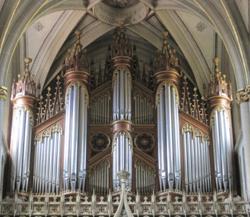
The Fondation Académie d’Orgue de Fribourg is offering a scholarship for organ students who wish to study at Fribourg University of Music in the academic year 2014–15. The successful candidate will also be invited to play a concert in the Fribourg International Organ Festival. Closing date for applications is March 30, 2014. Applicants must have been admitted at the Fribourg University of Music (HEMU—Haute Ecole de Musique: www.hemu.ch).
All candidates must send the application form, a detailed curriculum vitae, a copy of academic degrees, a copy of ID and three letters of recommendation to: Fribourg Organ Academy, C.P. 51, CH 1700, Fribourg, Switzerland.
Candidates may also be required to do an audition.
At the same time all candidates must apply for the entrance examination at HEMU by contacting Jean-Pierre Chollet, director of HEMU, at: Jean-Pierre.CHOFribourgLLET@hemu-cl.ch. The scholarship audition can be done the same day as the entrance exam. For further information contact: info@academieorgue.ch.


